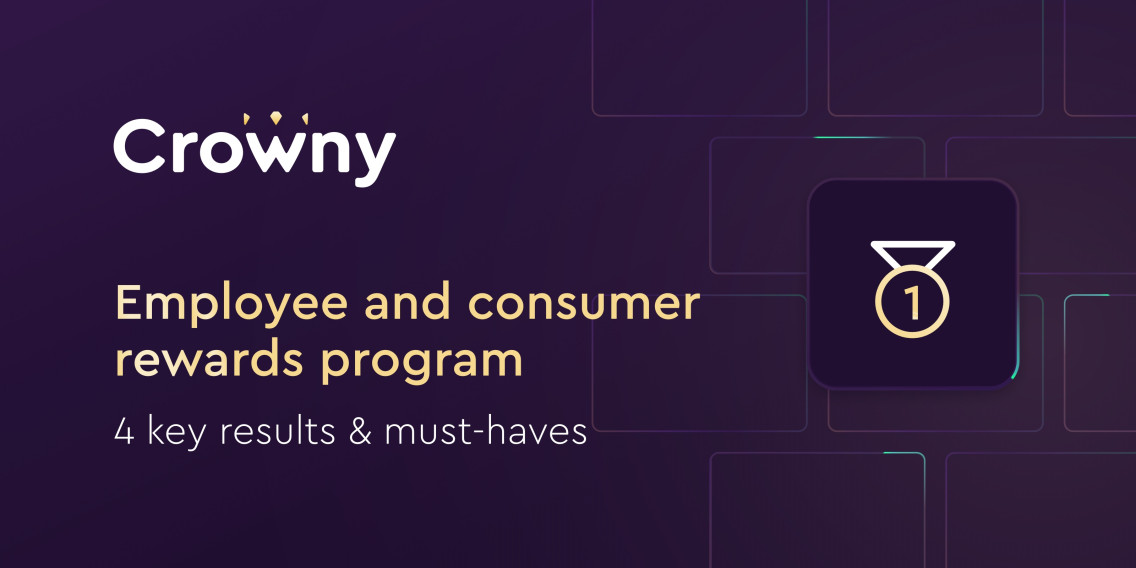An employee and consumer rewards program can be similar, but both have their benefits and issues. What are the 4 key results and must-haves you need to get ahead in your industry?
Table of contents:
✅ Employee rewards programs
✅ Consumer loyalty programs
✅ What are the differences?
✅ 4 key results
✅ 4 must-haves
✅ Why you should have a program
What are employee rewards programs?
Employee rewards programs are designed to give your employees a way to earn points and redeem those points for products or experiences. This is commonly done through a points-based system. You may also want to consider a tiered program where points can be redeemed for different items depending on how many points were earned. There are a couple of different types of loyalty program principles you could apply. This can allow your employees to redeem rewards that are most relevant to their needs. Employee rewards programs can be as simple as giving employees points for meeting certain goals, like helping customers, or as complicated as giving out points for completing certain tasks.
96% of employers believe they are taking adequate steps to retain employees, compared to 52% of U.S. workers who feel the same - Source
What are consumer rewards programs?
Consumer rewards programs are traditionally designed to encourage repeat purchases and increase brand loyalty by giving your customers points for each purchase they make. You can offer these rewards in a variety of ways. One popular method is to offer a percentage-based reward program. Another method is to offer a fixed-value rewards program. The methods are either based on the amount of their purchase or the percentage of the price. Some businesses may even offer negative points for returned items to encourage customers to be more careful with the products they use. Customers can redeem their points for discounts on future purchases or gift cards.
What are the differences between employee and consumer rewards programs?
Both are more than just a punch card that grants you free fries after a certain number of visits to your local fast-food restaurant. It’s much more than that. A rewards program in general is a strategy or set of tools used by businesses to motivate individuals to stay connected and engaged with the business, to improve business performance. Rewards programs can be segmented into employee and consumer programs. While both serve different purposes and have unique benefits, they can be similar in their use of points, incentives, and redemption.
Key results of an employee and consumer rewards program
Employee rewards program
An employee rewards program is designed to encourage employees to perform specific tasks or activities. Some examples of employee rewards programs include wellness programs, attendance programs, performance programs, and safety programs. An employee rewards program can have various results, such as:
☑️ Increased measurable business results with program tracking
☑️ Better management through improved employee insights
☑️ Boosted employee engagement for better individual performance
☑️ More aligned workforce as a result of frequent company value sharing
Consumer rewards program
A customer loyalty program is designed to reward customers for their purchases. Customers can earn points for their loyalty. Rewards programs give customers opportunities for recognition and self-reinvention through different challenges and activities regularly. A consumer rewards program can have various results, such as:
☑️ A positive brand image
☑️ Increased customer lifetime values
☑️ Sustainable brand loyalty
☑️ Long-term revenue growth
These are just some of the more generic loyalty program benefits for an employee and consumer rewards program. Once a program is tailored to its target audience and implemented properly, many more upsides can be included in this list.
Must-haves for an employee and consumer rewards program
An incentive program is designed to reward employees for hitting certain goals, like increasing sales or improving customer satisfaction. It’s important to note that you should only offer rewards if you are confident you can come through on your promise. With the rise of blockchain-based tokenized economies, rewards programs have become much more accessible to all businesses worldwide. It will potentially be the reason why points-based loyalty programs will grow exponentially in the years to come. Early-adopting businesses are expected to benefit from most of the developments. Here are some of the must-haves for programs of the future:
☑️ Easy-to-use customer loyalty software
☑️ Efficient and scalable loyalty solutions
☑️ Next-level targeting methods based on data
☑️ Personalised user experiences that enhance engagement
Another crucial element of a loyalty program is its implementation and use in the customer journey, which can be seen as relevant to both an employee and consumer rewards program. It’s something that has been massively overlooked by traditional loyalty programs for some time now. Most programs of today are not making use of the opportunities that are present, and therefore aren’t able to reach the full potential of loyalty programs.
Why you should have an employee and consumer rewards program
There are many benefits to having a rewards program, including increased sales, positive word-of-mouth, and improved customer satisfaction. Your employees will also feel appreciated as they work towards earning rewards. Benefits include increased retention rates due to the positive work environment, positive word-of-mouth because of the fun atmosphere created by these programs, as well as increased sales from customers who feel more inclined to return again and again because of the points they have accrued from purchases. Especially with blockchain-based loyalty rewards, the list of reasons is endless.
Blockchain has the potential to reduce 30% of banks' infrastructure costs - that's more than $10 billion every year. Source
The ultimate rewards program
The main issue businesses are experiencing with these methods is that the rewards usually don’t improve community engagement. This is partly to blame for the absence of an opportunity to include these traditional loyalty mechanisms in a brand’s omnichannel marketing strategy. To grow your user base connected to the loyalty program, the program needs exposure. Besides, the incredibly valuable community engagement some of the most loyal consumers generate is not getting rewarded. Traditional loyalty programs have performed decently over time, but don’t cover all the needs of today’s standards anymore.
With Crowny’s results-driven loyalty app and loyalty platform, businesses can now tackle the issues and accelerate their path to a thriving community. Whether this community contains consumers or employees, the solution we offer combines the best the marketing and loyalty industry has to offer. The platform will be launching soon.
Don’t wait too long, sign up to get early access now.

